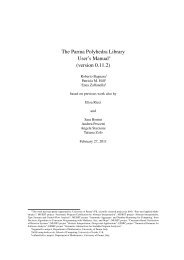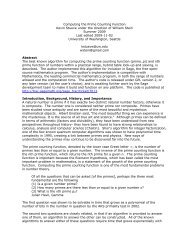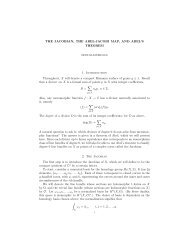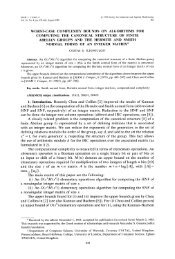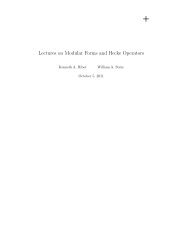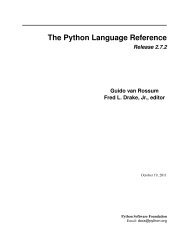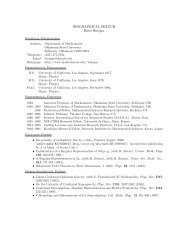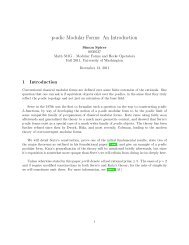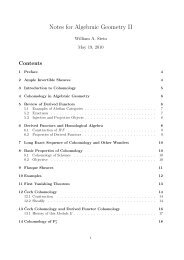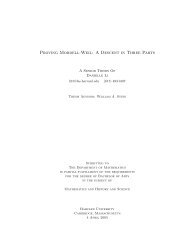Efficient implementation of the Hardy-Ramanujan ... - William Stein
Efficient implementation of the Hardy-Ramanujan ... - William Stein
Efficient implementation of the Hardy-Ramanujan ... - William Stein
Create successful ePaper yourself
Turn your PDF publications into a flip-book with our unique Google optimized e-Paper software.
IMPLEMENTATION OF THE HRR FORMULA Page 5 <strong>of</strong> 19<br />
and if k 1 is odd or divisible by 8, <strong>the</strong>n<br />
{<br />
k 2 2d 2 en 1 ≡ d 2 en+(k 2 2 −1)/d 1 mod k 1<br />
k 2 1 d 1en 2 ≡ d 1 en+(k 2 1 −1)/d 2 mod k 2<br />
(2.9)<br />
where d 1 = gcd(24,k 1 ), d 2 = gcd(24,k 2 ), 24 = d 1 d 2 e.<br />
Here (k 2 −1)/d denotes an operation done on integers, ra<strong>the</strong>r than a modular division. All<br />
o<strong>the</strong>r solving steps in (2.2)–(2.9) amount to computing greatest common divisors, carrying<br />
out modular ring operations, finding modular inverses, and computing modular square roots.<br />
Repeated application <strong>of</strong> <strong>the</strong>se formulas results in Algorithm 2, where we omit <strong>the</strong> detailed<br />
arithmetic for brevity.<br />
Algorithm 2 Fast algorithm for evaluating A k (n)<br />
Input: Integers k ≥ 1, n ≥ 0<br />
Output: s = A k (n), where A k (n) is defined as in (1.6)<br />
Compute <strong>the</strong> prime factorization k = p λ1<br />
1 pλ2 2 ...pλj j<br />
s ← 1<br />
for 1 ≤ i ≤ j and while s ≠ 0 do<br />
if i < j <strong>the</strong>n<br />
(k 1 ,k 2 ) ← (p λi<br />
i ,k/pλi i )<br />
Compute n 1 ,n 2 by solving <strong>the</strong> respective case <strong>of</strong> (2.7)–(2.9)<br />
s ← s×A k1 (n 1 ) {Handle <strong>the</strong> prime power case using (2.2)–(2.6)}<br />
(k,n) ← (k 2 ,n 2 )<br />
else<br />
s ← s×A k (n) {Prime power case}<br />
end if<br />
end for<br />
return s<br />
2.3. Computational cost<br />
A precise complexity analysis <strong>of</strong> Algorithm 2 should take into account <strong>the</strong> cost <strong>of</strong> integer<br />
arithmetic.Multiplication,division,computation<strong>of</strong>modularinverses,greatestcommondivisors<br />
and Jacobi symbols <strong>of</strong> integers bounded in absolute value by O(k) can all be performed with<br />
bit complexity O(log 1+o(1) k).<br />
At first sight, integer factorization might seem to pose a problem. We can, however, factor<br />
all indices k summed over in (1.4) in O(n 1/2 log 1+o(1) n) bit operations. For example, using<br />
<strong>the</strong> sieve <strong>of</strong> Eratos<strong>the</strong>nes, we can precompute a list <strong>of</strong> length n 1/2 where entry k is <strong>the</strong> largest<br />
prime dividing k.<br />
A fixed index k is a product <strong>of</strong> at most O(logk) prime powers with exponents bounded<br />
by O(logk). For each prime power, we need O(1) operations with roughly <strong>the</strong> cost <strong>of</strong><br />
multiplication, and O(1) square roots, which are <strong>the</strong> most expensive operations.<br />
To compute square roots modulo p λ , we can use <strong>the</strong> Tonelli-Shanks algorithm [To91, Sh72]<br />
or Cipolla’s algorithm [Ci03] modulo p followed by Hensel lifting up to p λ . Assuming that<br />
we know a quadratic nonresidue modulo p, <strong>the</strong> Tonelli-Shanks algorithm requires O(log 3 k)<br />
multiplications in <strong>the</strong> worst case and O(log 2 k) multiplications on average, while Cipolla’s<br />
algorithm requires O(log 2 k) multiplications in <strong>the</strong> worst case [CP05]. This puts <strong>the</strong> bit<br />
complexity <strong>of</strong> factoring a single exponential sum A k (n) at O(log 3+o(1) k), and gives us <strong>the</strong><br />
following result:



